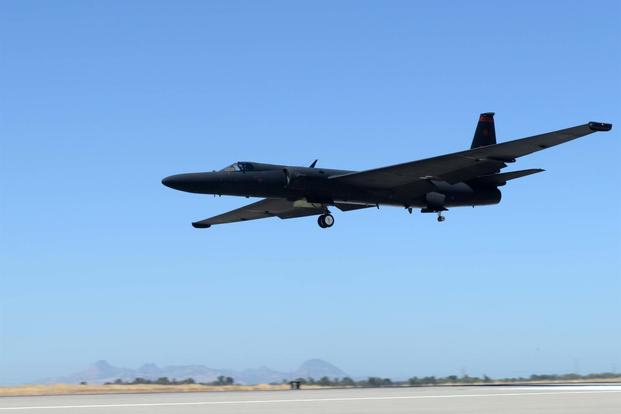Lt. Col. Ira S. "Shooter" Eadie, a U-2 Dragon Lady instructor pilot, may not have been fully secured in his ejection seat when his student unexpectedly stalled a TU-2S in midair and they were forced to eject, according to an Air Force investigation report.
Eadie, assigned to the 1st Reconnaissance Squadron, part of the 9th Reconnaissance Wing, sustained fatal injuries during the Sept. 20, 2016, accident in northern California.
While there was no evidence to suggest the belt was faulty, Eadie may not have been properly strapped in, according to a 1,254-page Accident Investigation Board report from Air Force Installation and Mission Support Center in response to a Freedom of Information Act request submitted by Military.com.
"Engineers from the Air Force Life Cycle Management Center concluded [Eadie] may not have been secured by his lap belt at the time of ejection," the document states.
Related content:
- Report: New U-2 Pilot Practiced Stall Maneuver Before Deadly Crash
- Air Force Identifies Pilot Killed in U-2 Crash
- Missing Engine Parts Caused F-16 Crash Near DC, Air Force Says
The incident occurred during an "acceptance flight" of the reconnaissance aircraft as the trainee pilot was practicing his third "approach to stall" maneuver with Eadie. The trainee put the aircraft into an unintentional second stall.
The stall caused the Dragon Lady's wing to dip between 70 and 80 degrees of its bank, and the nose to dip 35 to 40 degrees below the horizon, the investigation found.
As the aircraft approached the minimum uncontrolled ejection altitude, Eadie called for an immediate ejection.
Switched Trainers
The day began with the crew switching to a different U-2 trainer than planned, the report noted, as the aircraft slated for the day was undergoing maintenance.
"The mishap crew was scheduled to launch in a different aircraft, but due to mechanical issues, the mishap crew was redirected to the [mishap aircraft], which was the designated spare aircraft," causing a slight delay to their morning flight, the report said.
Furthermore, "When the mishap crew was redirected to the spare [mishap aircraft], operations duty desk personnel requested a change in [TU-2S]'s fuel load from an R-2 fuel load [level], of 888 gallons, to an R-3 fuel load, 1,088 gallons," which investigators said is standard for a Air Force training mission.
Brig. Gen. David Nahom, the accident investigation board's president, interviewed multiple witnesses for the report who could not recall how Eadie was strapped in before he and the pilot-in-training, identified only as a captain, took off.
Post-mishap images of both the captain's and Eadie's belt buckles were included in the records.
Connecting Linkage
According to the investigation, "Once the seat departs the aircraft, and after the first- and second-stage ejection seat rocket motors stop firing, a gas-operated ballistic disconnect mechanism releases the connecting linkage from the right lap belt.
"This feature automatically separates the right and left lap belts, releases the shoulder harness, and frees the pilot from the ejection seat," it said.
If everything is connected properly, both the front and backseater should eject smoothly.
"If the left and right lap belts are properly secured prior to ejection, the connecting linkage should remain locked onto the left lap belt by the locking lever," the report said.
The images provided showed the "disconnect mechanism on Eadie's right belt functioned properly and released the connecting linkage as designed; the locking lever on his left belt was found in the locked position with no damage or excessive wear," it said.
Unrecovered Belt Lever
However, Eadie's connecting lever between the right and left lap belt was not recovered.
If Eadie's lap belt was not secured, the shoulder harness would not have effectively restrained his torso to the seat back at the time of ejection, "which could have shifted the ejection seat's center of gravity and resulted in an unpredictable ejection trajectory," the report said.
The trainee pilot told Nahom he couldn't say whether Eadie was properly belted, but said Eadie didn't indicate to him he was loose in his seat.
"I don't know if he was strapped in or not. All I know is that he was strapped in by [the Physiological Support Squadron airman] and I never heard him say that he had unstrapped," the captain said in his testimony.
Nahom asked another witness, the mishap mobile officer, with the ground crew that day, "Do you know who was strapping [Eadie] in?" The officer could not recall.
Maintenance Error?
Upon reviewing more records, Nahom said that three months before this particular flight, a quality inspection of the low flight torso harnesses and regulators "was signed by an individual not fully qualified/trained to perform this task."
Yet Nahom said there is no reason to suggest this was a maintenance error.
The "9th Physiological Support Squadron (9 PSPTS), and 9th Operations Support Squadron (OSS) [Aircrew Flight Equipment] personnel performed all required inspections, documentation, and servicing of the equipment prior to flight," he wrote.
Nahom noted that there is not enough data to recreate the ejection trajectory that might have been caused by Eadie's potential weight shift at a time when the aircraft was already in an unstable, downward roll.
The report noted that it would have been "ideal" for the rear pilot to eject first. But because Eadie said, "Eject, dude," instead of the formal "bail out, bail out, bail out," the captain hesitated.
Eadie ejected before the captain. Regardless, it is believed Eadie attempted to take all precautions for his student before himself.
Immediately after ejection, and while still seated in the ejection seat, Eadie and his seat struck the TU-2S' right wing, causing his death.
“The Sutter County medical examiner concluded [the mishap instructor pilot] died of blunt force injuries to the head and neck, and that these injuries were instantaneously fatal,” the report said.
The two-seater U-2 trainer aircraft was assigned to the 1st Reconnaissance Squadron, part of the 9th Reconnaissance Wing, at Beale Air Force Base, California.
The aircraft crashed in Sutter County, California, and was completely destroyed. The loss of aircraft was estimated to be approximately $32 million.
The base paused operations for 72 hours after the crash.
Pilot Still Flying
According to a toxicology report, Eadie had diphenhydramine in his system -- or Benadryl.
The over-the-counter medication, commonly used for allergies, can often cause drowsiness and sedation. Witnesses interviewed said Eadie was "alert and excited" -- describing him as ready before the flight.
Eadie served in both the Navy and Air Force, with a combined service of 20 years.
The student pilot had roughly 2,000 flying hours in the T-6 Texan, T-38C Talon, C-17A Globemaster and T-38A, according to his interview with Nahom. He graduated from the Air Force Academy in 2008.
Air Combat Command said the captain is still flying.
"The pilot remains in flying status," ACC spokeswoman Erica Vega told Military.com on Tuesday.
"He has since completed the U-2S training program, and is a fully qualified U-2 pilot," she said in an email. "The report did not find any misconduct on the part of the pilot."
-- Oriana Pawlyk can be reached at oriana.pawlyk@military.com. Follow her on Twitter at @Oriana0214.












